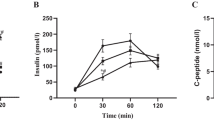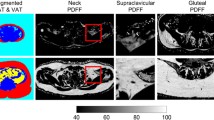Abstract
Background: It has been suggested that increased hepatic and intramuscular fat is associated with insulin resistance, and that increased pancreatic fat is related to impaired insulin secretion. Objective: We postulated that in obese nondiabetic teenagers insulin levels would be directly related to increases in intramuscular and hepatic fat and inversely related to increases in pancreatic fat. Materials and methods: MRI was used to assess the percentage of fat in the liver, muscle and pancreas in 15 healthy Mexican-American girls, 14–17 years old, with body mass indexes (BMIs) ranging from 17.7 kg/m2 to 46 kg/m2. Results: Strong correlations were observed between BMI and fat content in the liver, muscle, and pancreas (r2s between 0.50 and 0.89; P<0.003). Serum insulin levels were closely associated with fat measures in the muscle and liver (r2s=0.63 and 0.29, and P=0.001 and P=0.023, respectively). In contrast to our hypothesis, fat content in the pancreas was also directly related to insulin secretion (r2=0.74; P=0.001). Summary: We conclude that in nondiabetic teenagers, obesity is associated with an increased accumulation of fat in the pancreas without impairment of insulin secretion.





Similar content being viewed by others
References
Zimmet PZ (1999) Diabetes epidemiology as a tool to trigger diabetes research and care. Diabetologia 42:499–518
Miller J, Rosenbloom A, Silverstein J (2004) Childhood obesity. J Clin Endocrinol Metab 89:4211–4218
Fagot-Campagna A (2000) Emergence of type 2 diabetes mellitus in children: epidemiological evidence. J Pediatr Endocrinol Metab 13[Suppl 6]:1395–1402
Aye T, Levitsky LL (2003) Type 2 diabetes: an epidemic disease in childhood. Curr Opin Pediatr 15:411–415
Katzmarzyk PT (2002) The Canadian obesity epidemic, 1985–1998. CMAJ 166:1039–1040
Mokdad AH, Serdula MK, Dietz WH, et al (1999) The spread of the obesity epidemic in the United States, 1991–1998. JAMA 282:1519–1522
Schaffer JE (2003) Lipotoxicity: when tissues overeat. Curr Opin Lipidol 14:281–287
Poitout V (2004) Beta-cell lipotoxicity: burning fat into heat? Endocrinology 145:3563–3565
Carpentier A, Mittelman SD, Bergman RN, et al (2000) Prolonged elevation of plasma-free fatty acids impairs pancreatic beta-cell function in obese nondiabetic humans but not in individuals with type 2 diabetes. Diabetes 49:399–408
Lee Y, Hirose H, Ohneda M, et al (1994) Beta-cell lipotoxicity in the pathogenesis of non-insulin-dependent diabetes mellitus of obese rats: impairment in adipocyte-beta-cell relationships. Proc Natl Acad Sci USA 91:10878–10882
McGarry JD (2001) Dysregulation of fatty acid metabolism in the etiology of type 2 diabetes. Diabetes 51:7–18
Unger RH (2002) Lipotoxic diseases. Annu Rev Med 53:319–336
Dixon W (1984) Simple proton spectroscopic imaging. Radiology 153:189–194
Tanner JM (1978) Physical growth and development. In: Forfar JO, Arnell CC (eds) Textbook of Pediatrics. Churchill Livingstone, Edinburgh, pp 249–303
Desbuquois B, Aurbach GD (1971) Use of polyethylene glycol to separate free and antibody-bound peptide hormones in radioimmunoassays. J Clin Endocrinol Metab 33:732–738
Stenman UH, Pesonen K, Ylinen K, et al (1984) Rapid chromatographic quantitation of glycosylated haemoglobins. J Chromatogr 297:327–332
Yki-Jarvinen H, Kauppila M, Kujansuu E, et al (1992) Comparison of insulin regimens in patients with non-insulin-dependent diabetes mellitus. N Engl J Med 327:1426–1433
Perseghin G, Scifo P, De Cobelli F, et al (1999) Intramyocellular triglyceride content is a determinant of in vivo insulin resistance in humans: a 1H-13C nuclear magnetic resonance spectroscopy assessment in offspring of type 2 diabetic parents. Diabetes 48:1600–1606
Glover G, Schneider E (1991) Three-point Dixon technique for true water/fat decomposition with BO inhomogeneity correction. Magn Reson Med 18:371–383
Glover GH (1991) Multipoint Dixon technique for water and fat proton and susceptibility imaging. J Magn Reson Imaging 1:521–530
Guclu CC, Kovanlikaya I, Desai C, et al (2004) Lipid percentage measurements using three-point Dixon method. In: Proceedings of the 12th Annual Meeting of the ISMRM, Kyoto, 497 p
Bell DSH (2004) Management of type 2 diabetes with thiazolidinediones: link between β-cell preservation and durability of response. Endocrinologist 14:293–300
Zhou YP, Ling ZC, Grill VE (1996) Inhibitory effects of fatty acids on glucose-regulated β-cell function: association with increased islet triglyceride stores and altered effect of fatty acid oxidation on glucose metabolism. Metabolism 45:981–986
Unger RH (1995) Lipotoxicity in the pathogenesis of obesity-dependent NIDDM. Genetic and clinical implications. Diabetes 44:863–870
Iannucci A, Mukai K, Johnson D, et al (1984) Endocrine pancreas in cystic fibrosis: an immunohistochemical study. Hum Pathol 15:278–284
Moran A (1999) Cystic fibrosis related diabetes. In: Cystic Fibrosis Worldwide website http://www.cfww.org/pub/newsletter/nl01a/nl01af.htm
Shimabukuro M, Zhou YT, Lee Y, et al (1998) Troglitazone lowers islet fat and restores beta cell function of Zucker diabetic fatty rats. J Biol Chem 273:3547–3550
Lister CA, Moore GBT, Piercy V, et al (1999) Rosiglitazone, but not metformin or glibenclamide, improves glycaemic control and increases islet insulin content. Diabetologia 42:A150
Finegood DT, McArthur MD, Kojwang D, et al (2001) Beta-cell mass dynamics in Zucker diabetic fatty rats. Rosiglitazone prevents the rise in net cell death. Diabetes 50:1021–1029
Group. UKPS (1995) UK Prospective Diabetes Study 16. Overview of 6 years therapy of type 2 diabetes: a progressive disease. Diabetes 44:1249–1258
Netter FH (1970) The CIBA collection of medical illustrations: endocrine system and selected metabolic diseases. CIBA, New York
Schmitz-Moormann P, Pittner PM, Heinze W (1981) Lipomatosis of the pancreas. A morphometrical investigation. Pathol Res Pract 173:45–53
Cnop M, Grupping A, Hoorens A, l et al (2000) Endocytosis of low-density lipoprotein by human pancreatic beta cells and uptake in lipid-storing vesicles, which increase with age. Am J Pathol 156:237–244
Weichselbaum A, Stangl E (1902) Wien Klin Wochenschr 15:969–976
Acknowledgements
The authors would like to express their acknowledgement of and appreciation for the support of General Electric Medical Systems, Milwaukee, Wisconsin, USA.
Author information
Authors and Affiliations
Corresponding author
Rights and permissions
About this article
Cite this article
Kovanlikaya, A., Mittelman, S.D., Ward, A. et al. Obesity and fat quantification in lean tissues using three-point Dixon MR imaging. Pediatr Radiol 35, 601–607 (2005). https://doi.org/10.1007/s00247-005-1413-y
Received:
Revised:
Accepted:
Published:
Issue Date:
DOI: https://doi.org/10.1007/s00247-005-1413-y




